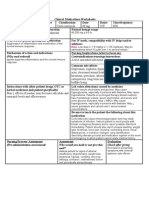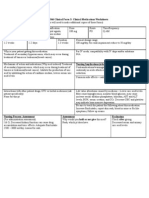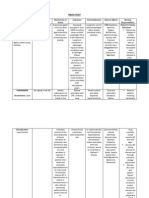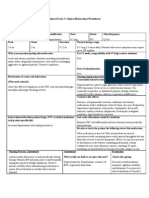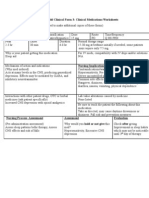100%(2)100% found this document useful (2 votes)
9K viewsLasix
Lasix
Uploaded by
Katie McPeekThis document provides information about the diuretic medication Lasix (furosemide). It lists the generic and trade names, classification, dose, administration route and schedule. It describes the mechanism of action as inhibiting sodium and chloride reabsorption, increasing urine output. Common side effects include dizziness, hypotension, dehydration and electrolyte imbalances. Nursing implications focus on monitoring fluid status, electrolytes and side effects. The evaluation involves assessing decreases in edema and blood pressure after administration.
Copyright:
Attribution Non-Commercial (BY-NC)
Available Formats
Download as DOC, PDF, TXT or read online from Scribd
Lasix
Lasix
Uploaded by
Katie McPeek100%(2)100% found this document useful (2 votes)
9K views1 pageThis document provides information about the diuretic medication Lasix (furosemide). It lists the generic and trade names, classification, dose, administration route and schedule. It describes the mechanism of action as inhibiting sodium and chloride reabsorption, increasing urine output. Common side effects include dizziness, hypotension, dehydration and electrolyte imbalances. Nursing implications focus on monitoring fluid status, electrolytes and side effects. The evaluation involves assessing decreases in edema and blood pressure after administration.
Copyright
© Attribution Non-Commercial (BY-NC)
Available Formats
DOC, PDF, TXT or read online from Scribd
Share this document
Did you find this document useful?
Is this content inappropriate?
This document provides information about the diuretic medication Lasix (furosemide). It lists the generic and trade names, classification, dose, administration route and schedule. It describes the mechanism of action as inhibiting sodium and chloride reabsorption, increasing urine output. Common side effects include dizziness, hypotension, dehydration and electrolyte imbalances. Nursing implications focus on monitoring fluid status, electrolytes and side effects. The evaluation involves assessing decreases in edema and blood pressure after administration.
Copyright:
Attribution Non-Commercial (BY-NC)
Available Formats
Download as DOC, PDF, TXT or read online from Scribd
Download as doc, pdf, or txt
100%(2)100% found this document useful (2 votes)
9K views1 pageLasix
Lasix
Uploaded by
Katie McPeekThis document provides information about the diuretic medication Lasix (furosemide). It lists the generic and trade names, classification, dose, administration route and schedule. It describes the mechanism of action as inhibiting sodium and chloride reabsorption, increasing urine output. Common side effects include dizziness, hypotension, dehydration and electrolyte imbalances. Nursing implications focus on monitoring fluid status, electrolytes and side effects. The evaluation involves assessing decreases in edema and blood pressure after administration.
Copyright:
Attribution Non-Commercial (BY-NC)
Available Formats
Download as DOC, PDF, TXT or read online from Scribd
Download as doc, pdf, or txt
You are on page 1of 1
NURS 2516 Clinical Medications Worksheets
Generic Trade Name Classification Dose Route Time/frequency
Name
Furosemide Lasix loop diuretics 20 mg IVP Today
Peak Onset Duration For IV meds, compatibility with IV drips and /or solutions
Direct IV-administer undiluted.
30 min 5 min 2 hours RATE: administer slowly over 1-2 min.
Mechanism of action and indications Nursing Implications (what to focus on)
(Why med ordered) Contraindications/warnings/interactions
Inhibits the reabsorption of sodium and chloride from the Hypersensitivity. Geriatric patients may have increased risk of
loop of Henle and distal renal tubule. Increases renal side effects, especially hypotension and electrolyte imbalance, at
excretion of water, sodium, chloride, magnesium, hydrogen, usual doses.
and calcium. May have renal and peripheral vasodilatory Common side effects
effects. Diuresis and subsequent mobilization of excess fluid CNS: dizziness, encephalopathy, headache, insomnia,
(edema, pleural effusions). Decreased blood pressure. nervousness, EENT: hearing loss, tinnitus, CV: hypotension,
GI: constipation, diarrhea, dry mouth, dyspepsia, nausea,
vomiting, GU: excessive urination, Derm: photosensitivity, rashes,
Endo: hyperglycemia, F and E: dehydration, hypochloremia,
hypokalemia, hypomagnesemia, hyponatremia, hypovolemia,
metabolic alkalosis, Hemat: blood dyscrasias, Metab:
hyperglycemia, hyperuricemia, MS: arthralgia, muscle cramps,
myalgia, Misc: increased BUN.
Interactions with other patient drugs, OTC or herbal Lab value alterations caused by medicine
medicines (ask patient specifically) Monitor electrolytes, renal and hepatic function, serum glucose,
↑ hypotension with antihypertensives , nitrates . and uric acid levels before and periodically throughout therapy.
May need to take a potassium supplement because lasix May cause ↓ serum potassium, calcium, and magnesium
concentrations. May also cause ↑ BUN, serum glucose, creatinine,
depletes K+ levels. and uric acid levels
Be sure to teach the patient the following about this
medication
Caution patient to change positions slowly to minimize orthostatic
hypotension. increased risk for falls. Suggest strategies for fall
prevention
Nursing Process- Assessment Assessment Evaluation
(Pre-administration assessment) Why would you hold or not give this Check after giving
Assess fluid status during therapy. Monitor daily med? Decrease in edema, Decrease in
weight, intake and output ratios, amount and Dehydration, hypokalemia, excessive abdominal girth, Decrease in
location of edema, lung sounds, skin turgor, and blood pressure. Monitor I & O
mucous membranes. Diuretic use is associated
dizziness or disorientation, tinnitus, Signs of ototoxicity.
with increased risk for falls in older adults. blurred vision
Assess falls risk and implement fall prevention
strategies. Assess patient for tinnitus and
hearing loss.
You might also like
- Hydrochlorothiazide ThiazideDocument1 pageHydrochlorothiazide ThiazideE100% (1)
- Irbesartan (Avapro)Document1 pageIrbesartan (Avapro)ENo ratings yet
- Drug Card LasixDocument2 pagesDrug Card LasixAdrianne Bazo100% (1)
- NURS 1566 Clinical Form 3: Clinical Medications WorksheetsDocument1 pageNURS 1566 Clinical Form 3: Clinical Medications WorksheetsAdhaNo ratings yet
- FurosemideDocument1 pageFurosemideCassie100% (1)
- Clinical Medication ListDocument181 pagesClinical Medication Listsophia onu100% (2)
- Naplex Complete Study Outline A Topic-Wise Approach DiabetesFrom EverandNaplex Complete Study Outline A Topic-Wise Approach DiabetesRating: 4 out of 5 stars4/5 (3)
- NarcanDocument1 pageNarcanKatie McPeekNo ratings yet
- LisinoprilDocument1 pageLisinoprilKatie McPeekNo ratings yet
- Generic Name FurosemideDocument1 pageGeneric Name FurosemideChristopher LeeNo ratings yet
- Furosemide (Lasix)Document1 pageFurosemide (Lasix)E100% (3)
- Drug StudyDocument8 pagesDrug StudyJheryck SabadaoNo ratings yet
- Clinical Medication WorksheetDocument1 pageClinical Medication WorksheetSrkocher100% (1)
- Furosemide: Online AudioDocument4 pagesFurosemide: Online AudioDani PhilipNo ratings yet
- Zaroxolyn MetolazoneDocument1 pageZaroxolyn MetolazoneCassieNo ratings yet
- DrugsDocument20 pagesDrugsLee Won100% (1)
- Drug Study (MS)Document9 pagesDrug Study (MS)Kristine GallardoNo ratings yet
- Pedia Drug StudyDocument11 pagesPedia Drug StudyPeetah PanNo ratings yet
- NURS 1566 Clinical Form 3: Clinical Medications WorksheetsDocument1 pageNURS 1566 Clinical Form 3: Clinical Medications WorksheetsCassie100% (1)
- Lisinopril Prinivil Zestril)Document1 pageLisinopril Prinivil Zestril)ENo ratings yet
- PrednisoloneDocument2 pagesPrednisoloneKatie McPeekNo ratings yet
- Solu-Cortef (Hydrocortisone)Document3 pagesSolu-Cortef (Hydrocortisone)E100% (2)
- HydrochlorothiazideDocument1 pageHydrochlorothiazideKatie McPeekNo ratings yet
- Mefenamic Acid Drug ProfileDocument3 pagesMefenamic Acid Drug ProfileAhmad WaliNo ratings yet
- Diuretics: Mrs. Davis, MSN/RN 2020Document36 pagesDiuretics: Mrs. Davis, MSN/RN 2020HannaNo ratings yet
- Drug Study TemplateDocument3 pagesDrug Study Templateralphocampo53No ratings yet
- Drug LordsDocument25 pagesDrug LordsGlen DaleNo ratings yet
- Drug LisinoprilDocument1 pageDrug LisinoprilSrkocherNo ratings yet
- Drug StudyDocument19 pagesDrug StudyLovely EsguerraNo ratings yet
- Diuretics-Decierdo (1)Document49 pagesDiuretics-Decierdo (1)wishnieizelwyn.daguioNo ratings yet
- Drug Study ICUDocument4 pagesDrug Study ICUArthadian De PeraltaNo ratings yet
- Micro K (Potassium Chloride)Document2 pagesMicro K (Potassium Chloride)ENo ratings yet
- Methylprednisolone (Solu Medrol)Document3 pagesMethylprednisolone (Solu Medrol)Adrianne Bazo100% (1)
- CU Task 11 RLE - Urinary Problems in Older Adults - GROUP2E 3Document7 pagesCU Task 11 RLE - Urinary Problems in Older Adults - GROUP2E 3FERMIL PASGALANo ratings yet
- Drug StudyDocument9 pagesDrug Studykcbabee0333% (3)
- Zyloprim Drug CardDocument1 pageZyloprim Drug CardSheri490No ratings yet
- Drug Name Dose, Route, Frequency Mechanism of Drug Indications Adverse Effects Contraindications Nursing ResponsibilitiesDocument15 pagesDrug Name Dose, Route, Frequency Mechanism of Drug Indications Adverse Effects Contraindications Nursing ResponsibilitiesitsmechachaNo ratings yet
- Drug StudyDocument10 pagesDrug StudyHelen ReonalNo ratings yet
- HCTZDocument1 pageHCTZSheri490100% (1)
- GROUP 6 - Medications (HF)Document34 pagesGROUP 6 - Medications (HF)Sunshine CabarrubiasNo ratings yet
- Generic Name: Brand Name: Lasix Classification: Loop DiureticsDocument5 pagesGeneric Name: Brand Name: Lasix Classification: Loop DiureticsKat ZNo ratings yet
- FUROSEMIDEDocument6 pagesFUROSEMIDEPark JeongyeonNo ratings yet
- Drug Action Indication Contraindication Adverse Effect Nursing ResponsibilitiesDocument8 pagesDrug Action Indication Contraindication Adverse Effect Nursing ResponsibilitiesKhim CaronanNo ratings yet
- Benazepril (Lotensin)Document1 pageBenazepril (Lotensin)E100% (1)
- Drug Study 68-75Document8 pagesDrug Study 68-75joshua_santiago_5No ratings yet
- Common MedicationsDocument12 pagesCommon MedicationsJasmeen KaurNo ratings yet
- Ix. Pharmacologic Management Brand Name Classification Indication Mechanism of Action Dosage and Frequency Adverse Reactions Nursing ConsiderationDocument21 pagesIx. Pharmacologic Management Brand Name Classification Indication Mechanism of Action Dosage and Frequency Adverse Reactions Nursing ConsiderationDizerine Mirafuentes RolidaNo ratings yet
- Ncp&drugstudDocument12 pagesNcp&drugstudSarah Mae Billano BermudezNo ratings yet
- Key Drug Information: FurosemideDocument2 pagesKey Drug Information: Furosemideamaliea234No ratings yet
- Abellar - Drug Study SpironolactoneDocument13 pagesAbellar - Drug Study SpironolactoneJeah Bearl AbellarNo ratings yet
- Drug Study For ITPDocument25 pagesDrug Study For ITPMary Ann QuinonesNo ratings yet
- Drug Study On PtuDocument4 pagesDrug Study On PtuDizzy BualanNo ratings yet
- DrugsDocument7 pagesDrugsEloisa Abarintos RacalNo ratings yet
- Definitions OF DiagnosisDocument25 pagesDefinitions OF DiagnosisGlaire ZarateNo ratings yet
- DTRDocument63 pagesDTRAlex SilvanoNo ratings yet
- Critical Care Medications: Anti-Arrhythmics Study Guide: Critical Care EssentialsFrom EverandCritical Care Medications: Anti-Arrhythmics Study Guide: Critical Care EssentialsNo ratings yet
- Top 100 Drugs Pocket Reference Guide (2023 Edition)From EverandTop 100 Drugs Pocket Reference Guide (2023 Edition)No ratings yet
- Phytotherapy in the Management of Diabetes and Hypertension: Volume 2From EverandPhytotherapy in the Management of Diabetes and Hypertension: Volume 2No ratings yet
- PulmicortDocument2 pagesPulmicortKatie McPeek100% (2)
- ValiumDocument1 pageValiumKatie McPeekNo ratings yet
- ZofranDocument1 pageZofranKatie McPeek0% (1)
- HaldolDocument2 pagesHaldolKatie McPeek100% (2)
- XopenexDocument1 pageXopenexKatie McPeekNo ratings yet
- Tag A MetDocument1 pageTag A MetKatie McPeekNo ratings yet
- VigamoxDocument1 pageVigamoxKatie McPeekNo ratings yet
- SynthroidDocument3 pagesSynthroidKatie McPeekNo ratings yet
- Re QuipDocument1 pageRe QuipKatie McPeekNo ratings yet
- Pro To NixDocument2 pagesPro To NixKatie McPeekNo ratings yet
- SenokotDocument1 pageSenokotKatie McPeek100% (1)
- PrednisoloneDocument2 pagesPrednisoloneKatie McPeekNo ratings yet
- RestorilDocument1 pageRestorilKatie McPeek100% (1)
- Re Me RonDocument2 pagesRe Me RonKatie McPeekNo ratings yet
- ZofranDocument1 pageZofranKatie McPeek0% (1)
- MorphineDocument2 pagesMorphineKatie McPeek100% (2)
- NURS 1566 Clinical Form 3: Clinical Medications Worksheets: Medical Patients With Acute Illness - 40 MG Once DailyDocument3 pagesNURS 1566 Clinical Form 3: Clinical Medications Worksheets: Medical Patients With Acute Illness - 40 MG Once DailyKatie McPeekNo ratings yet
- LortabDocument2 pagesLortabKatie McPeek100% (1)
- PhenerganDocument2 pagesPhenerganKatie McPeekNo ratings yet
- PrazosinDocument1 pagePrazosinKatie McPeek0% (1)
- Pep CidDocument1 pagePep CidKatie McPeekNo ratings yet
- Lo Press orDocument1 pageLo Press orKatie McPeekNo ratings yet
- LovenoxDocument1 pageLovenoxKatie McPeek100% (2)
- MultivitaminDocument1 pageMultivitaminKatie McPeek88% (8)
- LevaquinDocument1 pageLevaquinKatie McPeek100% (1)
- LevofloxacinDocument2 pagesLevofloxacinKatie McPeek100% (3)
- Influenza VaccineDocument1 pageInfluenza VaccineKatie McPeekNo ratings yet
- HydrochlorothiazideDocument1 pageHydrochlorothiazideKatie McPeekNo ratings yet

































